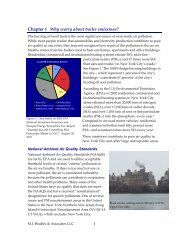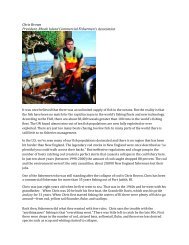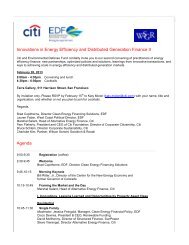Quota Management Area 3B. Historically, the main fishery has been concentrated onthe Chatham Rise. Annual orange roughy catches in ORH 3B were mostly just over30,000 t in the 1980s but progressively decreased since 1989–90 because of a series ofTACC reductions.169. Sullivan, K.J. (Comp.) 2004: Report from the Mid-Year Fishery Assessment Plenary, November2004: stock assessments and yield estimates. 46 p. (Unpublished report held in NIWA GretaPoint library, Wellington.) http://www.fish.govt.nz/sustainability/decisions/rk-lbstrplenary-2004.pdf.Stock assessment of New Zealand Rock Lobster for 2004, includinghistorical biomass, catch, and TAC. This report summarizes the conclusions andrecommendations of the Mid-Year Fishery Assessment Plenary session held duringNovember 2004, held to assess the rock lobster fishery managed within the QuotaManagement System.170. Summary commercial statistics 1996-2005. Retrieved March 12, 2006, fromhttp://www-sci.pac.dfo-mpo.gc.ca/sa/Commercial/AnnSumm_e.htm. Reports fromthe Department of Fisheries and Oceans, Canada, provide catch statistics (landings,value, landings by month) on BC groundfish, BC halibut, and BC sablefish from 1996-2005.171. Terry, J., Kirkley, J., 2006. Assessments of Excess Fishing Capacity in Select Federally ManagedCommercial Fisheries. NOAA and NMFS. March 31. There is excess capacity in manyfisheries in the U.S. and elsewhere. That is, fishing capacity exceeds actual catch.Persistently high levels of excess capacity can make it more difficult to meetconservation and management objectives, including the following eight broadobjectives: 1. Sustainable levels of catch and the subsequent biological, ecological,social, and economic benefits; 2. Bycatch that is minimized to the extent practicable;3. Efficient or economically viable harvesting and processing operations; 4.Stable/viable fishing communities; 5. Fishery management programs that are notunnecessarily costly, complex and intrusive; 6. Safe fishing operations; 7. Habitatconservation; and 8. Productive and sustainable marine ecosystems. Therefore,assessing fishing capacity and controlling the level and use of fishing capacity is ahigh priority for many countries, and it is an integral part of U.S. efforts toimplement ecosystem approaches to management. This report documents fishingcapacity using Data Envelopment Analysis (DEA) for major fisheries in the U.S.including specific assessments in the northeast region, highly migratory species,southeast region, Pacific coastal pelagics, Pacific islands region, and Alaskanfisheries.172. Turris, B. 2000. A comparison of British Columbia's ITQ Fisheries for Groundfish Trawl andSablefish: Similar Results from Programmes with Differing Objectives, Designs, and Processes in Useof Property Rights in Fisheries Management, FAO Fisheries Technical Paper 404/1. InCanada, the implementation of ITQs in commercial fisheries has been slow, disjointedand generally fishery specific. There has been no general government policy supportingor recommending that fisheries move to ITQs. Indeed the move to ITQs in a specificfishery was more likely the result of a dramatic failure of the existing managementregime that led front line fishery managers and associated industry participants toconsider alternative management approaches. This is clearly the case in the British- 30 -
Columbia commercial sablefish and groundfish trawl fisheries. Both fisheries were inunsustainable situations (in terms of stock abundance and economic viability) and theneed for changing the management structure was overwhelming. Although bothfisheries chose to implement ITQs and have seen similar improvements in stability,sustainability, and economic viability, the objectives and processes used to bring aboutthe ITQ programmes differed significantly and resulted in programme designs withmore differences than similarities. While some of the differences are entirely an artifactof the species harvested and the gear used, others are characteristic of the breadth ofparticipants and their social and political views. The paper 1) provides somebackground to both the sablefish and groundfish trawl fisheries and how they evolvedfrom limited entry derby fisheries to ITQ fisheries, 2) provides a brief description abouteach ITQ programme and the rules, which govern the fishery, 3) poses a number ofretrospective questions and answers to give a feel for how well, or poorly, theprogramme has done and the level of support from various industry participants, and4) looks into the future and discuss the direction these programmes may take andchanges that may be forth coming.173. U.S. Commission on Ocean Policy. 2004. An Ocean Blueprint for the 21st Century. FinalReport. Washington, DC.http://www.oceancommission.gov/documents/full_color_rpt/welcome.html. Study bya commission created by the U.S. Congress to draw a blueprint for a new,comprehensive, and sustainable ocean policy. The report provides recommendedactions on the topics of improved governance, sound science for wise decisions,improving ocean education, specific fishery and watershed management issues, andimplementation of a trust fund to support improved management.174. Virginia Marine Resources Commission (VAMRC), 2006. Commercial crabbing in VirginiaTidal Waters. Retrieved September 10, 2006 fromhttp://www.mrc.state.va.us/regulations/commercialcrabbingrules.shtm. Includesinformation on VA licenses, and fishery management measures.175. Wang, S.D., and Tang, V.H., 1994. The Performance of U.S. Atlantic Surf Clam and OceanQuahog Fisheries under Limited Entry and Individual Transferable Quota Systems. Gloucester,Mass.: National Marine Fisheries Service, Northeast Regional Office. Detailed report onthe surf clam and ocean quahog fishery including economic analyses, concentration,effort.176. Wang, S., Tang, V., 1996. The Surf Clam ITQ Management: An Evaluation. Economic statusof U.S. fisheries. Summary of surf clam ITQ including historical data on vessels andfishery effort (hours fished).177. Weeks, H., Hutton, L. 1997. Shoreside Whiting Observation Program: 1997. Marine FinfishProgram, Oregon Department of Fish and Wildlife.http://hmsc.oregonstate.edu/odfw/reports/wh1997_rpt.pdf. The Pacific WhitingShoreside Observation Program was established in 1992 to provide information forevaluating bycatch in the directed Pacific whiting fishery and for evaluatingconservation measures adopted to protect salmon and other prohibited species. Theprogram has been continued annually in order to account for all catch in targetedwhiting trips and to accommodate the landing of non-sorted catch from these trips. In- 31 -
- Page 4 and 5: fishery, which is regulated by 2-mo
- Page 6 and 7: 30. Clark, W., St-Pierre, G., 1997.
- Page 8 and 9: eleas/2001/nr024_e.htm. Description
- Page 10 and 11: 61. Gislason, GS, 2002. BC Seafood
- Page 12 and 13: 72. Hall-Arber, M. et al. 2004. New
- Page 14 and 15: Description of the 2005 IPHC regula
- Page 16 and 17: 94. Maryland Commercial Fisheries,
- Page 18 and 19: uyer broker, an increased competiti
- Page 20 and 21: http://www.fakr.noaa.gov/ram/daily/
- Page 22 and 23: Harvest by Port e.g. http://www.fak
- Page 24 and 25: 133. Pacific Fishery Management Cou
- Page 26 and 27: September. The paper focused on DAP
- Page 28 and 29: the Maritimes of Canada. Three stud
- Page 32: 1995, the program changed its empha


![Annotated bibliography [PDF] - Environmental Defense Fund](https://img.yumpu.com/50613332/30/500x640/annotated-bibliography-pdf-environmental-defense-fund.jpg)

![What do we mean by MSY? [PDF]](https://img.yumpu.com/49525661/1/190x245/what-do-we-mean-by-msy-pdf.jpg?quality=85)
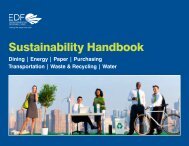
![Print version [PDF] - Environmental Defense Fund](https://img.yumpu.com/46812189/1/190x201/print-version-pdf-environmental-defense-fund.jpg?quality=85)
![Mercury Alert: Cleaning up Coal Plants for Healthier Lives [PDF]](https://img.yumpu.com/45587786/1/190x143/mercury-alert-cleaning-up-coal-plants-for-healthier-lives-pdf.jpg?quality=85)
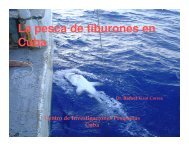

![Program Overview [PDF] - Environmental Defense Fund](https://img.yumpu.com/34005758/1/190x96/program-overview-pdf-environmental-defense-fund.jpg?quality=85)
